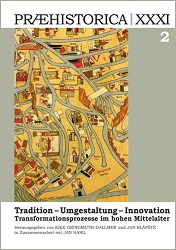Die Herausbildung der mittelalterlichen Kulturlandschaft im Land Lebus westlich der Oder – Umbrüche und Transformationen
The Formation of the Medieval Cultural Landscape in Terra Lubus (Lebus) West of the River Oder – Modifications and Transformations
Author(s): Sabine AltmannSubject(s): Cultural history, Social history, Social development, 13th to 14th Centuries
Published by: Univerzita Karlova v Praze, Nakladatelství Karolinum
Keywords: 13th century; terra lubus (Lebus); Leubuzzi; settlement area; castles; rural settlements; cultural landscape; Silesian ruler Henry I; Brandenburgian marcgraves; Cistercians; Templars; Augustinian;
Summary/Abstract: Since the beginning of 13th century the land settlement of the medieval region called terra lubus, situated on the river Oder, had been modified. As part of the settlement area of the Slavic Leubuzzi thereby, the region was not only characterized by its location between different rulerships but also by the encounter of immigrating Flemish settlers and the local Slavic population. The process of modification was initiated by the Silesian ruler Henry I and continued after the second half of the thirteenth century by the new rulers, the Brandenburgian marcgraves. Under Silesian as well as under Brandenburgian rulers the development was promoted in the same way: by the construction of new central places and the establishment of rural settlements oriented on growing wheat. All these processes were accompanied by disruptions in the developments as can be recognized in the abandoning of the Slavic castles or the loss of the central economic function of the former central place. Transformations took place as well, as the reorganization of pre-existing settlements or the transfer of special administrative or economic functions from the former main place to new central places show. The local Slavic population played an important role in this process. Depending on the numbers of Slavic settlements existing in the different areas of the region, they respectively the pre-existing structures were enclosed in the process to varying degrees, in all parts of the region as well as under the different rulers.
Journal: Praehistorica
- Issue Year: 31/2013
- Issue No: 2
- Page Range: 167-185
- Page Count: 19
- Language: German

